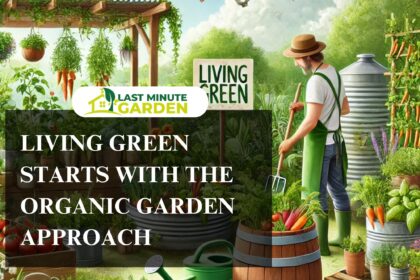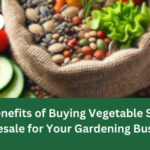Hi there! If you’re looking to add some charm and structure to your garden, organic garden edging might just be what you need. Not only is it visually appealing, but it’s also eco-friendly and sustainable, making it a great choice for any environmentally-conscious gardener.
Organic garden edging is a natural way to define different areas of your garden, whether it’s separating your flower beds from your lawn or creating borders around mulched areas. It’s a great way to enhance the overall look of your garden and make it more organized and put together.
In this article, we’ll explore the benefits of organic garden edging, different types of natural materials you can use, installation and maintenance tips, design ideas, and much more. Let’s get started!
Key Takeaways:
- Organic garden edging provides a natural way to define different areas of your garden.
- It enhances the overall look of your garden while also being eco-friendly and sustainable.
- In this article, we’ll explore the benefits of organic garden edging, different types of natural materials you can use, installation and maintenance tips, design ideas, and more.
Why Choose Organic Garden Edging?
As someone who loves gardening, I understand the importance of taking care of the environment while creating a beautiful outdoor space. Organic garden edging is an excellent way to achieve both of these goals.
One of the most significant reasons to choose organic garden edging is its eco-friendly nature. Unlike other types of garden borders that may contain harmful chemicals or toxins, organic garden edging is chemical-free and non-toxic, making it a safer option for both the environment and your family.
Another reason to choose organic garden edging is its contribution to sustainable gardening practices. By using natural materials such as rocks, stones, or logs, you can create a sustainable landscape border that blends seamlessly with your garden.
Organic garden edging can also help you control weed growth, retain soil moisture, and prevent erosion. It helps maintain the health of your garden, making it more visually appealing and environmentally friendly.
Overall, choosing organic garden edging is an excellent way to enhance your outdoor space while keeping the environment in mind. It’s a decision that you won’t regret, and your garden will thank you for it.
Types of Organic Garden Edging
Using organic materials in garden edging not only enhances the natural beauty of your green space but also promotes sustainability and eco-friendliness. There are various types of natural and organic materials that can be used for garden borders, each with its own unique charm and benefits.
| Material | Benefits |
|---|---|
| Stone or Rock | Durable and long-lasting, adds a rustic or modern feel to the garden depending on the style of stone used. |
| Logs or Branches | Creates a charming, woodland feel, perfect for a natural garden space. The logs can also serve as seating or steps! |
| Living Plants | Using plants as garden borders not only adds color and texture to the space, but also helps to attract pollinators and repel pests. |
When choosing your organic garden edging material, consider the overall style and vibe of your garden, as well as the specific benefits each material offers. For example, if you have a more modern garden design, using sleek, black river rocks would be a suitable choice.

Once you’ve selected the perfect materials for your organic garden edging, it’s time to get creative with the design. Consider using different types of materials together, such as combining stone and plants for a natural yet structured border, or using logs as a seat along the edge of your garden.
Remember, organic garden edging not only beautifies your space but can also help with weed control and soil moisture retention. Plus, it’s a sustainable and earth-friendly choice, making it a win-win for your garden and the planet.
Installation and Maintenance Tips
Now that you’ve decided to enhance your green space with organic garden edging, it’s time to get your hands dirty! Here’s a step-by-step guide to help you install your new eco-friendly borders:
Preparation: Before digging, mark out the area where you want to install the edging. Using a garden hose or rope can help create a clear border. Remove any grass or weeds along the edge to ensure a level base.
Digging: Use a spade or edger to create a trench to the depth of the edging material. This will usually be between 4-6 inches deep. The trench should be slightly wider than the width of the edging to allow for easy placement.
Securing: Once the edging is in place, secure it with stakes or pegs. These can be made from natural materials like bamboo or wood, or you can purchase metal or plastic stakes specifically designed for garden edging.
Maintenance: To keep your organic garden edging looking its best, regular maintenance is key. Remove any debris or dirt that accumulates near the edging to prevent it from becoming clogged. Trim any grass or plants that start to grow over the edging to maintain a clean, sharp border.
Remember, one of the benefits of organic garden edging is that it is sustainable and low maintenance. By using natural materials like stones or logs, you can create a long-lasting and earth-friendly garden border that requires minimal upkeep.

Design Ideas for Organic Garden Edging
When it comes to organic garden edging, the possibilities are endless. Natural materials like rocks, stones, or logs can be used to create attractive and functional garden borders that complement any landscape style.
One idea is to use large, flat rocks to create a clean and modern look. Place the rocks in a straight line along the border of your garden beds for a sleek, minimalist design.
If you’re looking for something more rustic, try using logs to create a raised garden bed. Simply stack them on top of each other, securing them in place with wooden stakes. This not only adds charm to your garden but also helps keep out pests and critters.
For a unique and artistic touch, consider incorporating colored glass bottles into your garden edging. Simply bury the bottles neck-down along the border of your garden, leaving the bottoms exposed. This adds an unexpected pop of color and is a great way to reuse and recycle old bottles.

If you have a cottage-style garden, consider using a combination of natural materials like stones, bricks, and plants to create a whimsical and charming border. Plant creeping thyme or other groundcovers in between the stones for a soft and inviting look.
Whatever your design preferences may be, organic garden edging provides an opportunity to get creative and enhance the overall aesthetic of your green space.
Benefits of Organic Garden Edging
Organic garden edging not only enhances the visual appeal of your green space but also offers various benefits for the overall health and sustainability of your garden. Here are some of the key benefits of using organic garden edging:
- Controls weed growth: Organic garden edging helps prevent weeds from spreading across your garden by creating a physical barrier that separates the plants from the surrounding grass or soil.
- Retains soil moisture: By keeping the soil in place and reducing water runoff, organic garden edging helps retain moisture in the soil for longer periods, reducing the need for frequent watering.
- Prevents erosion: Organic garden edging can effectively prevent soil erosion, which is especially important if you have a sloped garden or live in an area with heavy rainfall.
- Improves garden health: Organic garden edging made from natural materials like rocks or stones provides a habitat for beneficial insects and microorganisms that contribute to the health and fertility of your garden.
- Environmentally friendly: Unlike plastic or metal garden edging, organic materials are chemical-free and non-toxic, making them a sustainable choice for eco-conscious gardeners.
By incorporating organic garden edging into your landscape, you can create a beautiful and functional garden while promoting sustainable gardening practices.

Tips for Choosing the Right Organic Garden Edging
Choosing the right organic garden edging can make all the difference in creating an aesthetically pleasing and sustainable outdoor space. Here are some tips to help you choose the perfect eco-friendly garden borders for your needs:
- Consider functionality: Before selecting organic garden edging, consider the purpose it will serve. If you want to keep your garden free from grass and weeds, opt for edging that creates a physical barrier between your plants and the surrounding soil. If you’re looking to add a decorative element to your garden, choose edging that complements your landscape style.
- Think about durability: Organic garden edging materials vary in durability. While stones and rocks can weather the elements well, softer materials like wood may not last as long. Take into account the location of your garden and its exposure to sun, rain, and temperature changes when selecting the right material.
- Check for toxicity: Some organic garden edging materials may contain chemicals or toxins that can be harmful to both your garden and the environment. Make sure to select chemical-free and non-toxic edging options to keep your garden environmentally friendly.
- Match the surrounding landscape: The organic garden edging you choose should complement the surrounding landscape and match the aesthetic of your garden. Consider the color, texture, and size of the materials you’re using to ensure they blend seamlessly with your outdoor space.
By following these tips, you can choose the perfect organic garden edging to create a sustainable and visually appealing outdoor space that you can enjoy for years to come.

Conclusion
In conclusion, choosing organic garden edging is an excellent way to enhance and beautify your green space while also contributing to sustainable gardening practices. By using natural and eco-friendly materials, you can create beautiful borders that are free of harmful chemicals and toxins.
Not only does organic garden edging add aesthetic value to your outdoor space, but it also helps control weed growth, retain soil moisture, and prevent erosion. Plus, with a variety of materials to choose from, you can find the perfect organic garden edging to suit your garden’s specific needs and design.
When selecting the right organic garden edging for your space, consider factors such as functionality, durability, and compatibility with your surrounding landscape. With proper installation and maintenance, your organic garden edging will last for years, providing both beauty and environmental benefits.
So why not give organic garden edging a try? You’ll not only be enhancing the visual appeal of your green space but also doing your part in promoting a more sustainable and eco-friendly way of gardening.




